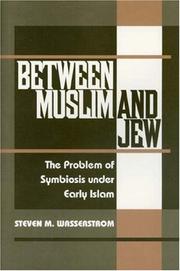| Listing 1 - 2 of 2 |
Sort by
|
Book
ISBN: 9789004383623 900438362X 9004383654 9789004383654 Year: 2019 Publisher: Leiden Brill
Abstract | Keywords | Export | Availability | Bookmark
 Loading...
Loading...Choose an application
- Reference Manager
- EndNote
- RefWorks (Direct export to RefWorks)
The present volume consists of translated anecdotes, on musicological and socio-cultural topics, from al-Iṣbahānī’s Kitāb al-Aghānī al-Kabīr ( The Grand Book of Songs ) with annotations and commentaries. It deals with musical rhythmic and melodic modes, technical terms and treatises; music instruments; composition techniques and processes; education and oral/written transmissions; vocal and instrumental performances and their aesthetics; solo and ensemble music; change and its inevitability; musical and textual improvisations; ṭarab and the acute emotions of joy or grief; medieval dances; social status. Though extracts from The Grand Book of Songs have been translated in European languages since 1816, this work presents a much larger and more comprehensive scope that will benefit musicologists, medievalist and Middle Eastern scholars as well as the general reader.
Music --- Music. --- History and criticism. --- Abū al-Faraj al-Iṣbahānī, --- Kitāb al-aghānī (Abū al-Faraj al-Iṣbahānī) --- 500-1400 --- Arab countries. --- Art music --- Art music, Western --- Classical music --- Musical compositions --- Musical works --- Serious music --- Western art music --- Western music (Western countries) --- Abū al-Faraj al-Iṣbahānī, --- Kitāb al-aghānī (Abū al-Faraj al-Iṣbahānī)

ISBN: 0691034559 1306984408 0691608970 1400864135 Year: 1995 Publisher: Princeton : Princeton University Press,
Abstract | Keywords | Export | Availability | Bookmark
 Loading...
Loading...Choose an application
- Reference Manager
- EndNote
- RefWorks (Direct export to RefWorks)
Steven Wasserstrom undertakes a detailed analysis of the "creative symbiosis" that existed between Jewish and Muslim religious thought in the eighth through tenth centuries. Wasserstrom brings the disciplinary approaches of religious studies to bear on questions that have been examined previously by historians and by specialists in Judaism and Islam. His thematic approach provides an example of how difficult questions of influence might be opened up for broader examination.In Part I, "Trajectories," the author explores early Jewish-Muslim interactions, studying such areas as messianism, professions, authority, and class structure and showing how they were reshaped during the first centuries of Islam. Part II, "Constructions," looks at influences of Judaism on the development of the emerging Shi'ite community. This is tied to the wider issue of how early Muslims conceptualized "the Jew." In Part III, "Intimacies," the author tackles the complex "esoteric symbiosis" between Muslim and Jewish theologies. An investigation of the milieu in which Jews and Muslims interacted sheds new light on their shared religious imaginings. Throughout, Wasserstrom expands on the work of social and political historians to include symbolic and conceptual aspects of interreligious symbiosis. This book will interest scholars of Judaism and Islam, as well as those who are attracted by the larger issues exposed by its methodology.Originally published in 1995.The Princeton Legacy Library uses the latest print-on-demand technology to again make available previously out-of-print books from the distinguished backlist of Princeton University Press. These editions preserve the original texts of these important books while presenting them in durable paperback and hardcover editions. The goal of the Princeton Legacy Library is to vastly increase access to the rich scholarly heritage found in the thousands of books published by Princeton University Press since its founding in 1905.
Islam --- Jews --- Judaism --- Relations --- Judaism. --- Intellectual life. --- Islam. --- History. --- Hebrews --- Israelites --- Jewish people --- Jewry --- Judaic people --- Judaists --- Ethnology --- Religious adherents --- Semites --- Religions --- Religion --- Adab (Islam). --- Ahmad al-Buni. --- Al-Amin. --- Al-Baladhuri. --- Al-Masudi. --- Allusion. --- Ancient Canaanite religion. --- Ancient Judaism (book). --- Arabic name. --- Arabs. --- Ark of the Covenant. --- B'nai Moshe. --- Bar Hebraeus. --- Baraita. --- Batiniyya. --- Berakhot (Talmud). --- Book of Daniel. --- Book of Leviticus. --- Comparative religion. --- Conversion to Judaism. --- Court Jew. --- Covenanter. --- Dual naming. --- Economy. --- Ethnic group. --- Ghulat. --- Halakha. --- Hanafi. --- Hebrew Bible. --- Hebrew name. --- Hermann Cohen. --- Homer. --- Husayn ibn Ali. --- Interfaith dialogue. --- Islam and the West. --- Islamic religious leaders. --- Islamic–Jewish relations. --- Israel. --- Israelites. --- Jewish Christian. --- Jewish diaspora. --- Jewish eschatology. --- Jewish history. --- Jewish leadership. --- Jewish mysticism. --- Jewish philosophy. --- Jewish prayer. --- Jewish religious movements. --- Jewish studies. --- Jews. --- Judah Halevi. --- Judeo-Christian. --- Julius Wellhausen. --- Karaite Judaism. --- Kitab al-Aghani. --- Kunya (Arabic). --- Law of Moses. --- Levantines (Latin Christians). --- Maimonides. --- Medium of exchange. --- Menahem. --- Merkava. --- Messianic Age. --- Messianism. --- Metatron. --- Moshe Gil. --- Muhammad ibn al-Hanafiyyah. --- Muslim. --- Muslims (nationality). --- Nation state. --- Norman Stillman. --- Persian Jews. --- Quran. --- Quraysh. --- Rabbinic Judaism. --- Reconstructionist Judaism. --- Religion. --- Religious text. --- Sectarianism. --- Sefer (Hebrew). --- Semitic people. --- Shema Yisrael. --- Shia Islam. --- Sikhism. --- Solomon Zeitlin. --- Solomon ibn Gabirol. --- Spread of Islam. --- Sunni Islam. --- Talmud. --- The Jews of Islam. --- Third Heaven. --- Tosefta. --- Trade route. --- Umma. --- Yazidis. --- Yemenite Jews. --- Zerubbabel. --- Zionism.
| Listing 1 - 2 of 2 |
Sort by
|

 Search
Search Feedback
Feedback About UniCat
About UniCat  Help
Help News
News